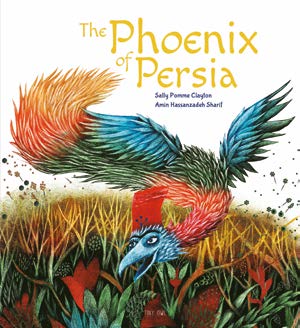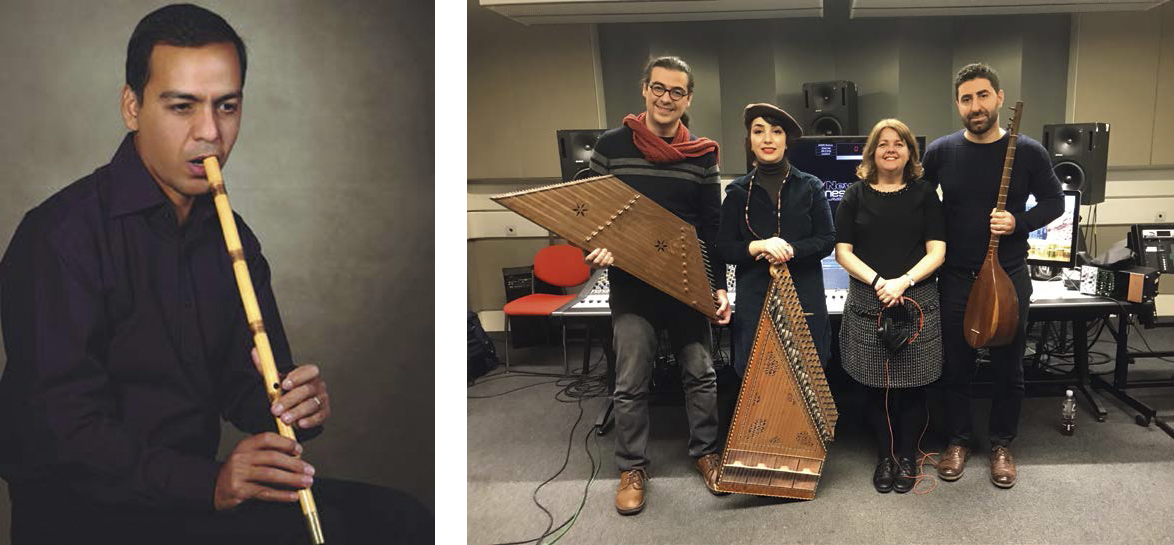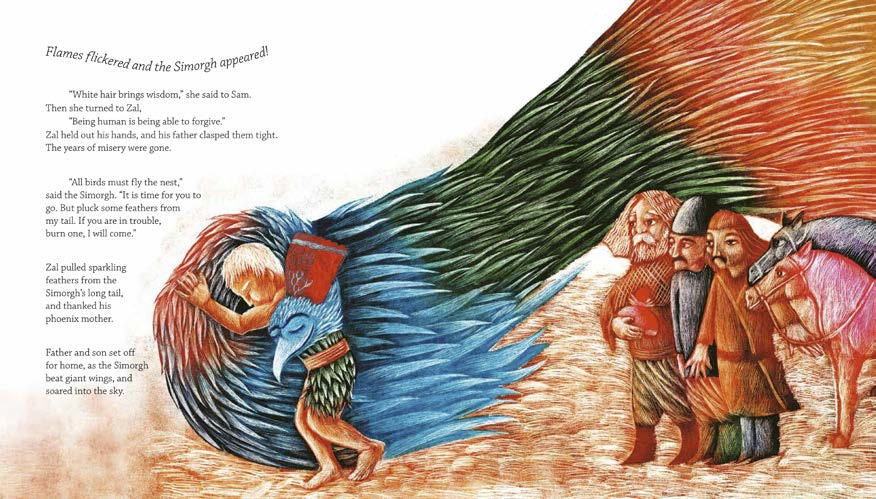The Phoenix of Persia Revives an Ancient Story as a Multimedia Picture Book

Phyllida Jacobs
If you travelled back a thousand years, to a coffee shop in ancient Persia, you would almost certainly encounter a rapt audience all gathered around, listening to a storyteller.
Amid the scents of coffee, ripe mulberries and walnuts, you might hear him recount tales from the epic Shahnameh, illustrated by an intricately painted pardeh wall hanging. You might experience the story of Prince Zal, the ancient Persian hero abandoned by his father only to be saved by the mythical bird Simorgh. Tiny Owl’s new picture book The Phoenix of Persia (2019) aims to recreate this rich storytelling experience for the new generation to enjoy. A retelling of the story of Zal and the phoenix Simorgh, this unique picture book is accompanied by an original musical composition and a recorded narration.
The project was initiated by Professor Laudan Nooshin of City University of London, who has been researching and writing about Iranian classical and popular music for more than 30 years. She had the idea of turning the story into a children’s book after working on a similar project with the Community and Education Department at the London Philharmonic Orchestra. After Professor Nooshin partnered with independent children’s book publisher Tiny Owl, author Sally Pomme Clayton reinterpreted the story in her own words. A professional storyteller with a long-standing fascination with ancient myths and fables, she co-founded the groundbreaking Company of Storytellers. Tapping into the ancient, global tradition of oral storytelling, her rich and poetic language breathes new life into old stories.
Tiny Owl was first started because its co-founder and publisher Delaram Ghanimifard, who is originally from Iran, couldn’t find books that reflected her sons’ heritage. The Phoenix of Persia has huge personal significance for her, as it’s based on an episode from Iran’s national epic the Shahnameh, or Book of Kings. Written by the tenth-century poet Ferdowsi, it tells the story of the Persian Empire from the beginning of the world to the Arab conquest of Iran in the seventh century. In this part of the story, King Sam awaits the birth of his son, but when the child is born with white hair, he is banished to the forest. Luckily for the baby Prince Zal, he is found by the mythical firebird Simorgh and raised in her nest. When the King and his son are reunited, they both learn a powerful lesson about forgiveness and acceptance. Although the story is mainly unknown to non-Iranian children, it carries echoes of Snow White and firebird folklore – including, of course, the phoenix Fawkes of Harry Potter fame – that will instantly feel familiar. The story is updated for contemporary readers but keeps the original poem’s sense of magic and mystery.

Amir Eslami (ney), Saeid Kord Mafi (santur), Nilufar Habibian (qanun), Sally Pomme Clayton (storyteller), Arash Moradi (tanbur). Copyright © 2019 Tiny Owl.
A huge part of what makes this book so special is the free music and narration that accompanies it. On opening the book, you’ll find a QR code that can be opened with any smartphone, no special app required. Simply point your camera at it and tap the link that appears to open Soundcloud and stream the music. Right away you’ll be struck by the unique sounds of the Iranian instruments featured, quite different from the sounds of a Western orchestra. Like Prokofiev’s classic composition Peter and the Wolf, each instrument represents a character in the story. The various sounds reflect the nature of the character. Our protagonist Zal is represented by the qanun, a type of Iranian zither played by plucking. The majestic firebird Simorgh is represented by the ney, a traditional reed flute. The music also features the sounds of the Iranian instruments tanbur, santur and daff (a type of lute, dulcimer and frame drum respectively). Hearing Sally Pomme Clayton’s narration alongside the music recreates the experience of listening to a storyteller, and provides many different ways to enjoy the story. Children might listen to the narration on its own or alongside the book to support their reading. They can even use the music track without narration as an accompaniment to their own telling of the story.
Professor Nooshin and Soosan Lolovar, a PhD student at City University, worked as Project Leader and Creative Producer to create the musical track. The musicians also acted as composers, improvising much of their parts as is common in traditional Iranian music. The music was mixed, mastered and edited by Julius Johansson and other students at City University.
The audio element of the book is complemented by its beautiful illustrations. The artwork illustrating the tale of Zal was created by Iranian artist Amin Hassanzadeh Sharif. He used a technique called ‘sgraffito’, in which an initial layer of bright colour is covered by a layer of black paint, which is then scratched away to reveal what lies beneath and create a pattern or image. The resulting illustrations mirror the beauty and intricacy of Persian miniature paintings or the elaborate backdrops used in traditional storytelling in Iran. They’re full of jewel-like tones that perfectly capture the sense of an ancient, mythical world filled with enchantment.

Illustration © Amin Hassanzadeh Sharif 2019, published by Tiny Owl Publishing © 2019.
As part of this hugely ambitious project, Tiny Owl partnered with Tower Hamlets School Libraries Service to create the Shahnameh Box, a free resource for schools to borrow. The box is packed with exciting materials to help enrich students’ understanding of Persian culture. It contains a copy of The Phoenix of Persia, the non-fiction book I is for Iran, and the Persian love story Bijan and Manije, another picture book from Tiny Owl. There are materials to help teachers create a beautiful display, including Iranian fabric and coins, patterned tiles, ‘phoenix’ feathers, dried rose petals, musical instruments, contemporary Persian miniatures and a matching game for students to play. Also included is a booklet of cross-curricular teacher resources to help schools plan lessons around the book. These comprehensive resources cover English, art, history, geography and more. Not only that, but The Phoenix of Persia was also brought to schools and venues all over the country through the annual Pop Up Festival. Children got to hear Sally Pomme Clayton’s spellbinding performance of the book, and enjoy artist workshops with Amin Hassanzadeh Sharif.
The Phoenix of Persia is the second book in Tiny Owl’s series One Story, Many Voices, which promotes cross-cultural understanding by sharing stories from around the world. When the world feels more divided than ever before, it is essential that we learn to appreciate and understand cultures different from our own. Middle Eastern countries, especially Iran, are presented in an overwhelmingly negative light in Western media, leading to stereotyping of people from these countries. The Phoenix of Persia shows children the beautiful culture and history of Iran, hopefully creating a more positive nuanced view of the country and its people. Traditional Iranian dramatic storytelling has been included in UNESCO’s list of Intangible Cultural Heritage in Need of Urgent Safeguarding. This book helps to revitalise this vibrant tradition and allow children from all backgrounds and cultures to experience its magic.
Creating The Phoenix of Persia has been a long journey for everyone at Tiny Owl. For co-founders Delaram Ghanimifard and Karim Arghandehpour it began in their childhoods when their parents and grandparents told them stories from the Shahnameh. When Professor Nooshin brought them the idea for The Phoenix of Persia two years ago, they were electrified by the idea of bringing these beloved stories to life. But they were also worried – would children find the sounds of Iranian music too unfamiliar?
Luckily, the children loved it! It has been wonderful to see children all over the UK enjoying the music that’s so integral to the Iranian storytelling tradition. We hope that The Phoenix of Persia will continue to fly to new readers, and open their minds to other cultures.
Works cited
Clayton, Sally Pomme (illus. Amin Hassanzadeh Sharif) (2019) The Phoenix of Persia (One Story, Many Voices). London: Tiny Owl.
Phyllida Jacobs is a Publisher’s Assistant at Tiny Owl.
